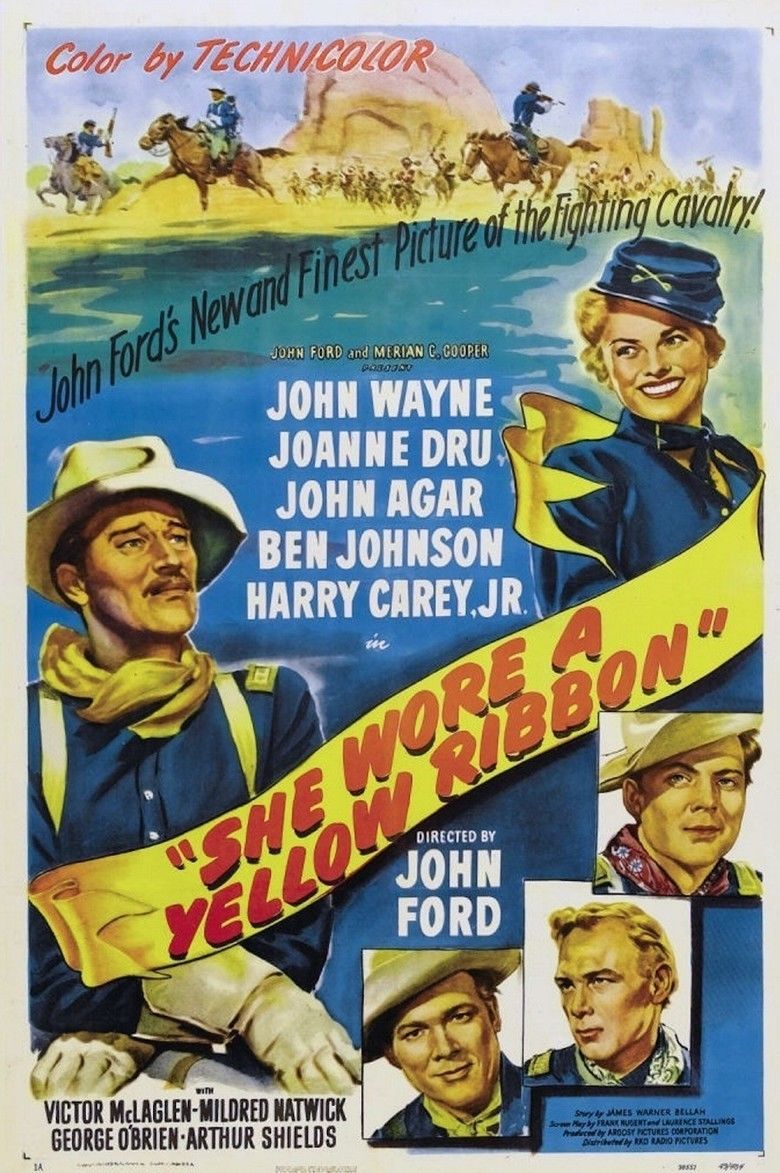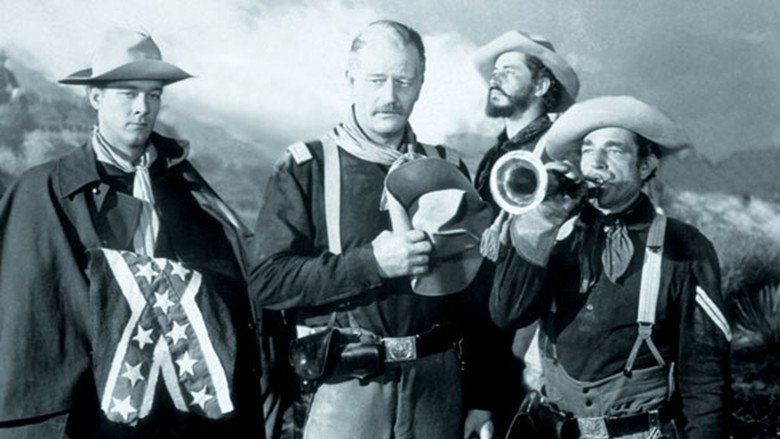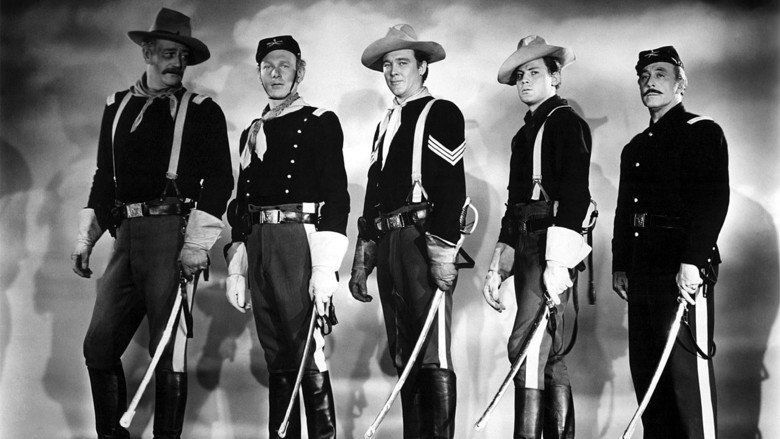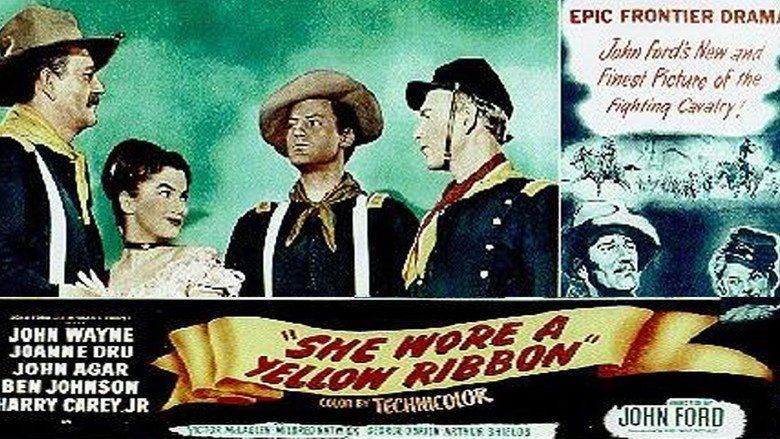She Wore a Yellow Ribbon
8.4 /10 1 Votes8.4
94% Rotten Tomatoes Duration Language English | 7.4/10 IMDb Country United States | |||||||||||||||||||||||||||||||||
 | ||||||||||||||||||||||||||||||||||
Release date July 26, 1949 (1949-07-26) (Premiere-Kansas City, KS)October 22, 1949 (1949-10-22) (US) Based on The Big Hunt1947 story in The Saturday Evening PostWar Party1948 in The Saturday Evening Post by James Warner Bellah Screenplay Frank Nugent, Laurence Stallings Cast (Capt. Nathan Cutting Brittles), (First Sergeant Quincannon), (Olivia Dandridge), (Lt. Flint Cohill), (Sgt. Tyree), Harry Carey, Jr. (2nd Lt. Ross Pennell)Similar movies Harry Potter and the Deathly Hallows: Part 1 , The Lord of the Rings: The Two Towers , RED , War Horse , The Last Airbender , The Glory Guys Tagline John Ford's New and Finest Picture of the Fighting Cavalry! | ||||||||||||||||||||||||||||||||||
She Wore a Yellow Ribbon is a 1949 Technicolor Western film directed by John Ford and starring John Wayne. The Academy Award winning film was the second of Ford's Cavalry trilogy films (the other two being Fort Apache (1948) and Rio Grande (1950)). With a budget of $1.6 million, the film was one of the most expensive Westerns made up to that time. It was a major hit for RKO. The film takes its name from "She Wore a Yellow Ribbon", a popular US military song that is used to keep marching cadence.
Contents

The film was shot on location in Monument Valley utilizing large areas of the Navajo reservation along the Arizona-Utah state border. Ford and cinematographer Winton Hoch based much of the film's imagery on the paintings and sculptures of Frederic Remington. The film won the Academy Award for Best Cinematography in 1950. It was also nominated as 1950's Best Written American Western (which the Writers Guild of America awarded to Yellow Sky).

She wore a yellow ribbon theme
Plot

On the verge of his retirement at Fort Starke, a one-troop cavalry post, aging US Cavalry Captain Nathan Cutting Brittles (John Wayne) is given one last mission: to take his troop and deal with a breakout from the reservation by the Cheyenne and Arapaho following the defeat of George Armstrong Custer at the Battle of the Little Big Horn.

Brittles' task is complicated by being forced at the same time to deliver his commanding officer's wife and niece, Abby Allshard (Mildred Natwick) and Olivia Dandridge (Joanne Dru), to an eastbound stage and by the need to avoid a new Indian war. His troop officers, 1st Lt. Flint Cohill (John Agar) and 2nd Lt. Ross Pennell (Harry Carey, Jr.), meanwhile vie for the affections of Miss Dandridge while uneasily anticipating the retirement of their captain and mentor.
Assisting him with his mission is Capt. Brittles' chief scout, Sgt. Tyree (Ben Johnson), a one-time Confederate cavalry officer; his first sergeant, Quincannon (Victor McLaglen); and Maj. Allshard (George O'Brien), Brittles' long-time friend and commanding officer.
After apparently failing in both missions, Brittles returns with the troop to Fort Starke to retire. His lieutenants continue the mission in the field, joined by Brittles after "quitting the post and the Army". Unwilling to see more lives needlessly taken, Brittles takes it upon himself to try to make peace with Chief Pony That Walks (Chief John Big Tree). When that too fails, he devises a risky stratagem to avoid a bloody war by stampeding the Indians' horses out of their camp, forcing the renegades to return to their reservation.
The film ends with Brittles being recalled to duty as chief of scouts with the rank of Lt. Colonel and Miss Dandridge and Lt. Cohill becoming engaged.
Cast
Director John Ford's older brother Francis appears in only one scene as Connolly, the barman. Ford kept Francis on wages "for eight weeks even through Francis could have completed his scenes in less than a week." Other uncredited cast members include: Harry Woods as Karl Rynders, the sutler; Cliff Lyons as Trooper Cliff; Mickey Simpson as Wagner, the blacksmith; Fred Libby as Corporal Kumrein; and Rudy Bowman as Private Smith. Among Rynders' associates is veteran character actor Paul Fix (Harry Carey, Jr.'s father-in-law) in a small uncredited role.
Casting
Director Ford initially was uncertain who to cast in the lead role. However, he knew that he did not want John Wayne for the part—considering, among other factors, that Wayne would be playing a character over twenty years older than he was at the time. Reportedly, Wayne's 1948 performance in Red River changed Ford's mind, causing him to exclaim, "I didn’t know the big son of a bitch could act!" Ford realized Wayne had grown considerably as an actor, and was now capable of playing the character he envisaged for this film. When shooting was completed, Ford presented Wayne with a cake with the message, "You're an actor now." The role also became one of Wayne's favorite performances.
Filming
The cast and crew lived in relatively primitive conditions in Monument Valley. Most slept in dirt-floor cabins that only had communal cold-water drum showers. The film was completed ahead of schedule and under budget.
Although the film's cinematographer, Winton Hoch, won an Academy Award for his work, filming was not a smooth creative process because of conflicts with Ford. Ironically one of the most iconic scenes from the film was created during a dispute. As a line of cavalry rode through the desert, a real thunderstorm grew on the horizon. Hoch began to pack up the cameras as the weather worsened only for Ford to order him to keep shooting. Hoch argued that there was not enough natural light for the scene and, more importantly, the cameras could become potential lightning rods if the storm swept over them. Ford ignored Hoch's complaints; completing the scene as the thunderstorm rolled in, soaking the cast and crew. Hoch later had filed a letter of complaint against Ford with the American Society of Cinematographers over the filming of this scene.
The story of Hoch's refusal to shoot in this thunderstorm has often been repeated, but actor Harry Carey, Jr., who was on the set, contests it. He says Ford had finished shooting for the day, but when the picturesque storm brewed he asked Hoch if they could shoot in the declining light. Hoch answered, "It's awfully dark, Jack. I'll shoot it. I just can't promise anything." Ford then instructed, "Winnie, open her up [the camera lens] and let's go for it. If it doesn't turn out, I'll take the rap." Winnie complied, saying, "Fair enough, Jack."
Publicity
A theater poster featured the male lead wearing a yellow neckerchief with his uniform and a yellow banner (with proportions and shape evocative of a stylish ribbon) him behind him, that also looped some 270 degrees around the female lead's shoulders.
Reception
The film is recognized by American Film Institute in these lists:
References
She Wore a Yellow Ribbon WikipediaShe Wore a Yellow Ribbon IMDbShe Wore a Yellow Ribbon Rotten TomatoesShe Wore a Yellow Ribbon themoviedb.org
